
- Usage in publication:
-
- Sandsuck shale*
- Modifications:
-
- Original reference
- Dominant lithology:
-
- Shale
- AAPG geologic province:
-
- Appalachian basin
Summary:
Pg. 3. Sandsuck shale. Bluish-gray shales with lighter-gray bands. Shales weather dull yellow. Thickness at least 1,000 feet. Lowest formation in Chilhowee Mountain. Undelries Cochran conglomerate. Age is Early Cambrian.
[Named from exposures on Sandsuck Branch of Walden Creek, Sevier Co., eastern TN. Extends into western NC.]
Source: US geologic names lexicon (USGS Bull. 896, p. 1909).
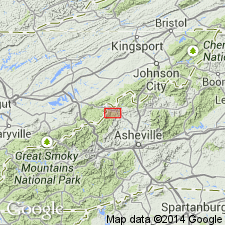
- Usage in publication:
-
- Sandsuck shale*
- Modifications:
-
- Revised
- AAPG geologic province:
-
- Piedmont-Blue Ridge province
Summary:
Sandsuck shale of Chilhowee group. In Hot Springs Window area, western North Carolina, Sandsuck shale is 800 to 1,000 feet thick. Underlies Cochran quartzite; overlies Vann quartzite (new). Replaces Hiwassee slate of Keith, 1904 (USGS Geol. Atlas of the US, Asheville folio). Age is Early Cambrian. Name substituted for Hiwassee slate of Keith.
Source: US geologic names lexicon (USGS Bull. 1200, p. 3439-3440).
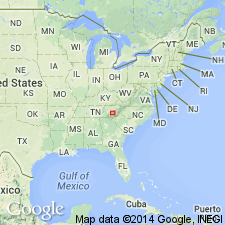
- Usage in publication:
-
- Sandsuck shale*
- Modifications:
-
- Age modified
- Revised
- AAPG geologic province:
-
- Appalachian basin
- Piedmont-Blue Ridge province
Summary:
Reassigned to Ocoee series. Age changed to later Precambrian. Consists of argillaceous shale with interbedded layers and lenses of limestone and of conglomerate (Citico conglomerate of Keith's earlier reports). Believed to be the top of Ocoee series and, because it lies directly under Chilhowee group rocks at its type locality, it is a better term than Wilhite or Hiwassee, terms used elsewhere by Keith for equivalent beds.
Source: GNU records (USGS DDS-6; Reston GNULEX).
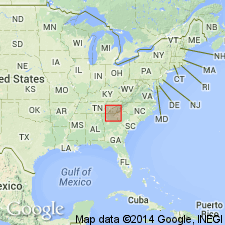
- Usage in publication:
-
- Sandsuck shale*
- Modifications:
-
- Age modified
- AAPG geologic province:
-
- Piedmont-Blue Ridge province
Summary:
Age changed to late Precambrian and Early Cambrian. [No explanation for change given in report.]
Source: GNU records (USGS DDS-6; Reston GNULEX).
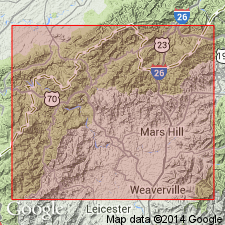
- Usage in publication:
-
- Sandsuck formation
- Modifications:
-
- Redescribed
- AAPG geologic province:
-
- Piedmont-Blue Ridge province
Summary:
Pg. 23-25. Sandsuck formation is used in this report [Hot Springs Window area, western North Carolina], for rocks between Unicoi above and Snowbird below. Keith's used of Hiwassee in Hot Springs area considered inappropriate. [Age is Precambrian (Ocoee).]
Source: GNU records (USGS DDS-6; Reston GNULEX).
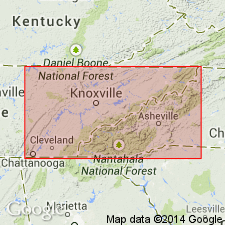
- Usage in publication:
-
- Sandsuck shale*
- Modifications:
-
- Revised
- AAPG geologic province:
-
- Appalachian basin
Summary:
Northeast of Pigeon River, Ocoee series is divided into an upper Sandsuck shale and a lower Snowbird formation. Southwest of Pigeon River, in foothills belt, Ocoee is divided into upper Sandsuck and lower Pigeon siltstone. Sandstone mapped northeast of Pigeon River corresponds roughly to what Keith (1904, Asheville folio) mapped as Hiwassee slate in same area. In present usage, Wilhite slate is a synonym for Sandsuck, but Citico conglomerate may be used as a member name for conglomerate beds and lenses within Sandsuck shale, especially south of Miller Cove fault. The Starr conglomerate lentil of the Sandsuck shale is abandoned; it was mapped in error by Hayes (1895) between Hiwassee River and Ocoee River and is a synonym for Cochran conglomerate.
Source: GNU records (USGS DDS-6; Reston GNULEX).
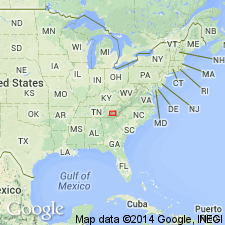
- Usage in publication:
-
- Sandsuck formation*
- Modifications:
-
- Revised
- AAPG geologic province:
-
- Appalachian basin
- Piedmont-Blue Ridge province
Summary:
Assigned to Walden Creek group (new) of Ocoee series. Revised to include sandstone and conglomerate formerly of the base of overlying Cochran formation. Base of Cochran is now at higher stratigraphic level and is marked by persistent beds of arkose and quartzite. Best exposure is not along Sandsuck Branch, but on northwest slope of Chilhowee Mountain. Base of Sandsuck is cut off by faults on both Chilhowee and English Mountains. Overlain by Cochran formation at both locations.
Source: GNU records (USGS DDS-6; Reston GNULEX).
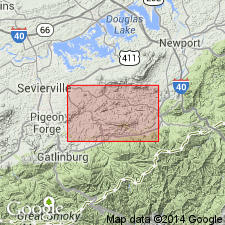
- Usage in publication:
-
- Sandsuck formation*
- Modifications:
-
- Revised
- AAPG geologic province:
-
- Appalachian basin
Summary:
Sandsuck formation is highest unit of Walden Creek group of Ocoee series. Its rocks resemble those of other formations in the group, but differ from overlying formations. Within map area, relations of Sandsuck to remainder of Walden Creek group are not proved; most of its contacts are faulted, but appears to lie in sequence above Wilhite formation in small area at northwest end of Pine Mountain. Composed of siltstone and fine-to coarse-grained sandstone. Fine-grained rocks form areas of low relief; sandstones form hills. Many exposures are in valleys. Divided into three unnamed members; lower and upper members both consists of interlaminated siltstone and fine-grained sandstone, with minor amounts of coarse-grained sandstone; middle member consists of coarse-grained sandstone and quartz conglomerate with minor amounts of fine-grained rock. Stratigraphic relations are uncertain; presumed concordance with other formations is inadequately shown. Lower contact is believed to be concordant with Wilhite formation; upper limit is probably present on north side of Rich Mountain, but Sandsuck of Rich Mountain is correlated with other rocks assigned to Sandsuck to the south based only on lithologic similarity. It is reasonable, although unproven, to place Sandsuck between rest of Walden Creek group and overlying Chilhowee group. Age is late Precambrian. Report includes geologic map, cross sections, correlation chart, and measured sections.
Source: GNU records (USGS DDS-6; Reston GNULEX).
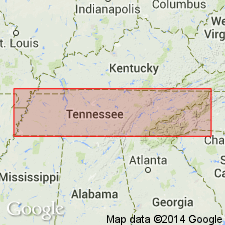
- Usage in publication:
-
- Sandsuck Formation
- Modifications:
-
- Areal extent
- AAPG geologic province:
-
- Appalachian basin
Summary:
In Great Smoky Mountains, used as Precambrian Sandsuck Formation of Walden Creek Group of Ocoee Supergroup.
Source: GNU records (USGS DDS-6; Reston GNULEX).
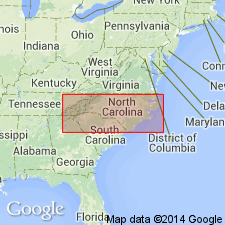
- Usage in publication:
-
- Sandsuck Formation
- Modifications:
-
- Areal extent
- AAPG geologic province:
-
- Piedmont-Blue Ridge province
Summary:
In Blue Ridge belt, used as Late Proterozoic Sandsuck Formation of Walden Creek Group Of Ocoee Supergroup. It is the only separately mapped formation of Walden Creek Group shown on map.
Source: GNU records (USGS DDS-6; Reston GNULEX).
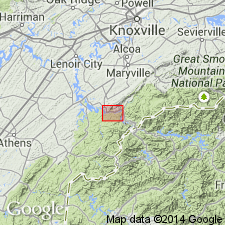
- Usage in publication:
-
- Sandsuck Formation
- Modifications:
-
- Revised
- AAPG geologic province:
-
- Appalachian basin
Summary:
The shale overlying the Wilhite Formation in the area south of English Mountain cannot be correlated with the Sandsuck Formation underlying the Chilhowee Group on Chilhowee Mountain and English Mountain. The name Sandsuck should not be used for this uppermost unit of the Walden Creek Group. A newly discovered fossil assemblage in the Wilhite Formation, including trilobite, ostracode, bryozoan, and microcrinoid fragments and agglutinated foraminifers prove a Silurian or younger age for the Walden Creek Group of the Ocoee Supergroup.
Source: GNU records (USGS DDS-6; Reston GNULEX).
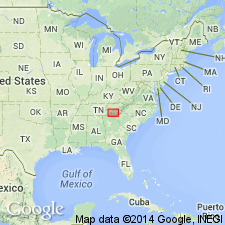
- Usage in publication:
-
- Sandsuck Formation
- Modifications:
-
- Age modified
- Biostratigraphic dating
- AAPG geologic province:
-
- Appalachian basin
Summary:
"Rediscovery of large, C-shaped soft-bodied metazoan fossils in the Sandsuck Formation in sequence with fossiliferous Chilhowee Group rocks suggests that the Sandsuck is no younger than Early Cambrian, and may still be Late Proterozoic."
Source: GNU records (USGS DDS-6; Reston GNULEX).
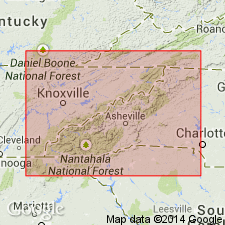
- Usage in publication:
-
- Sandsuck Formation
- Modifications:
-
- Biostratigraphic dating
- AAPG geologic province:
-
- Appalachian basin
Summary:
Upper part of the Ocoee Supergroup (the Shields, Wilhite, and Sandsuck Formations) are assigned to the Vendian (Late Proterozoic), based on occurrences of Vendian acritarchs in the Shields and Wilhite Formations. Authors state that it is beyond the scope of this paper to address the relative merits of the arguments presented by Unrug and Unrug (1990) or comment as the validity of their studies. Walker and Driese maintain that the Sandsuck, Wilhite, and Shield Formations of the Walden Creek Group form a continuous stratigraphic sequence with the overlying Chilhowee Group, which is dated here as Late Proterozoic and Early Cambrian on the basis of an assemblage of trace and body fossils --PALAEOPHYCUS, PLANOLITES, and SKOLITHOS.
Source: GNU records (USGS DDS-6; Reston GNULEX).
For more information, please contact Nancy Stamm, Geologic Names Committee Secretary.
Asterisk (*) indicates published by U.S. Geological Survey authors.
"No current usage" (†) implies that a name has been abandoned or has fallen into disuse. Former usage and, if known, replacement name given in parentheses ( ).
Slash (/) indicates name conflicts with nomenclatural guidelines (CSN, 1933; ACSN, 1961, 1970; NACSN, 1983, 2005, 2021). May be explained within brackets ([ ]).

